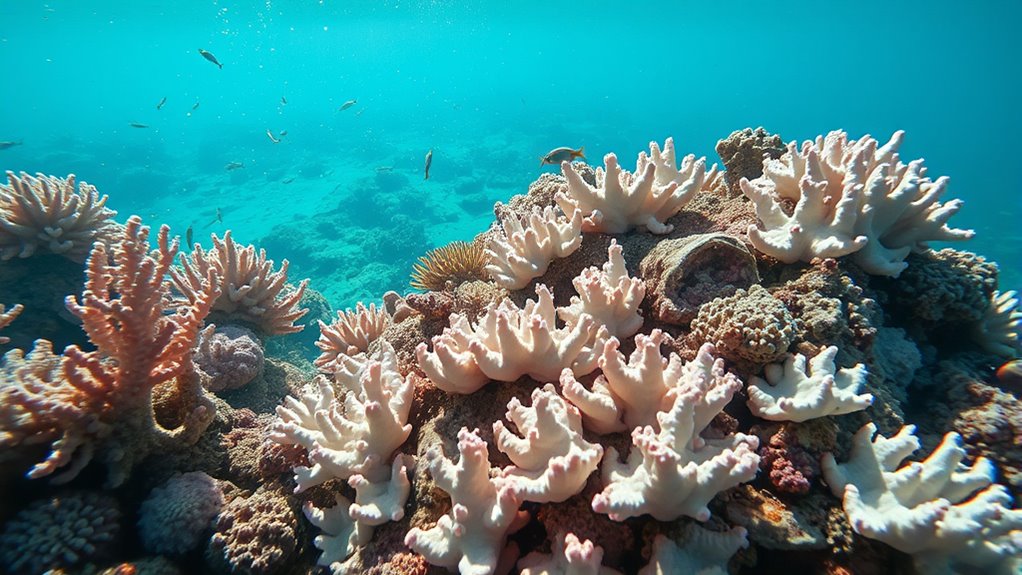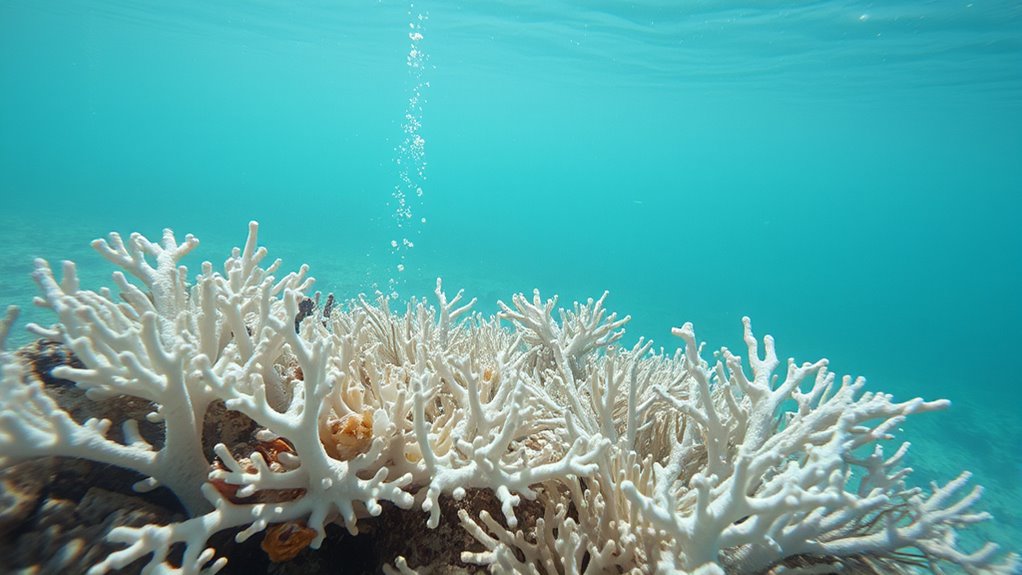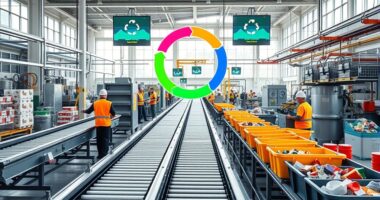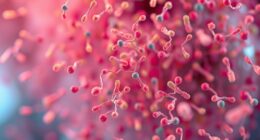Ocean acidification happens when carbon dioxide from human activities dissolves into seawater, causing the pH to drop and making the water more acidic. This process mainly results from burning fossil fuels that release CO₂ into the atmosphere, which then enters the ocean. The increased acidity harms marine life, especially creatures like corals and shellfish that rely on calcium carbonate to build their skeletons. To understand how these changes affect our oceans and future, keep exploring further.
Key Takeaways
- Ocean acidification results from CO₂ dissolving into seawater, lowering pH levels and altering ocean chemistry.
- The primary cause is increased atmospheric CO₂ from human activities like burning fossil fuels.
- Chemical changes hinder calcifying organisms, especially corals, leading to bleaching and ecosystem disruption.
- Broader impacts include harm to marine species with calcium carbonate shells and reduced biodiversity.
- Consequences threaten marine food security, coastal protection, and highlight the urgent need to reduce carbon emissions.

Ocean acidification occurs when carbon dioxide from human activities dissolves into seawater, causing the pH level of the ocean to drop. This chemical change has profound effects on marine life, especially on corals and the ecosystems they support. As the water becomes more acidic, corals struggle to build and maintain their calcium carbonate skeletons, leading to widespread coral bleaching. When corals bleach, they expel the symbiotic algae living within their tissues, losing their vibrant colors and, more critically, their primary energy source. Without these algae, corals become stressed, more vulnerable to disease, and less likely to recover from bleaching events. Over time, this disrupts the entire reef ecosystem, causing a decline in biodiversity and impacting species that depend on coral reefs for shelter and food.
Your presence in these environments means you’re witnessing the tangible effects of ocean acidification firsthand. As coral reefs degrade, so does the marine ecosystem that relies on them. Fish populations dwindle as their habitat shrinks, and species that depend on coral reefs for breeding grounds or nourishment find fewer resources available. This imbalance affects commercial fisheries and local communities that depend on fishing for their livelihoods. Additionally, the loss of coral reefs impacts the overall health of the ocean, as these structures act as natural barriers, protecting coastlines from storms and erosion. When reefs die off, coastal regions become more susceptible to damage, amplifying the destructive power of climate change.
The impacts of ocean acidification extend beyond corals. Many marine organisms, such as mollusks, crabs, and plankton, rely on calcium carbonate to form shells and skeletons. As acidity increases, these creatures find it harder to produce and maintain their structures, threatening their survival. This, in turn, affects the entire food chain, including larger predators and human communities that rely on seafood. The cascading effects threaten marine biodiversity, compromise food security, and alter the balance of entire ecosystems. Your awareness of these interconnected impacts underscores the urgency to address not only carbon emissions but also the broader consequences of ocean chemistry changes. Protecting our oceans requires understanding how acidification affects marine ecosystems and acting to mitigate its causes, ensuring that future generations can enjoy vibrant, thriving marine environments.
Frequently Asked Questions
How Does Ocean Acidification Affect Deep-Sea Ecosystems?
You might wonder how ocean acidification impacts deep-sea ecosystems. It reduces the availability of carbonate structures critical for many organisms, threatening deep sea biodiversity. As acidity increases, species that rely on these structures for habitat or survival struggle to thrive. This disruption can trigger a decline in population and biodiversity, destabilizing the delicate balance of life in the deep ocean. Your awareness helps highlight the importance of addressing this environmental issue.
Can Marine Organisms Adapt to Increased Acidity Over Time?
You wonder if marine organisms can adapt to increased acidity over time. While some species may develop marine adaptation, enhancing their acidity resilience, it’s uncertain how quickly or effectively this happens. Many organisms struggle to keep pace with rapid changes, risking decline or extinction. Your concern highlights the importance of understanding biological limits and supporting conservation efforts to protect ecosystems from the impacts of ocean acidification.
What Are the Economic Impacts of Ocean Acidification on Fisheries?
Think of ocean acidification as a storm brewing over your fishery. The economic consequences are severe, leading to a fishery decline that hits your income and local communities hard. As shellfish and other marine species struggle to survive, your catch shrinks, prices rise, and jobs disappear. The ripple effects threaten your livelihood, making it clear that addressing ocean health isn’t just environmental—it’s vital for economic stability too.
How Is Ocean Acidification Monitored Globally?
To monitor ocean acidification globally, you rely on advanced monitoring techniques like pH sensors, autonomous buoys, and satellite data. These tools track changes in ocean chemistry, especially pH levels, alkalinity, and dissolved carbon dioxide. You can access real-time data from international research networks and climate organizations, helping you understand how ocean chemistry shifts over time. Consistent monitoring is crucial to assess impacts and develop effective responses to acidification.
Are There Any Mitigation Strategies to Reverse Ocean Acidification?
You can explore mitigation strategies like geoengineering solutions and carbon sequestration to counteract ocean acidification. Geoengineering involves deliberate interventions, such as ocean alkalinity enhancement, to raise pH levels directly. Carbon sequestration captures CO2 before it reaches the oceans, reducing acidification. While promising, these methods require careful research and regulation. Implementing these strategies helps protect marine ecosystems and supports global efforts to combat acidification.
Conclusion
So, congratulations! You now know that dumping CO₂ into the ocean isn’t just turning your latte a little sour—it’s making the entire marine world breathe its last. But hey, who needs coral reefs or shellfish anyway? Keep ignoring science, keep polluting, and enjoy your beachfront property—until the ocean’s acidity levels turn your vacation into a toxic wasteland. Cheers to a future where we’re all swimming in a sea of our own neglect!









